This page is an automated translation of /nl/bitless.html and has not been reviewed yet.
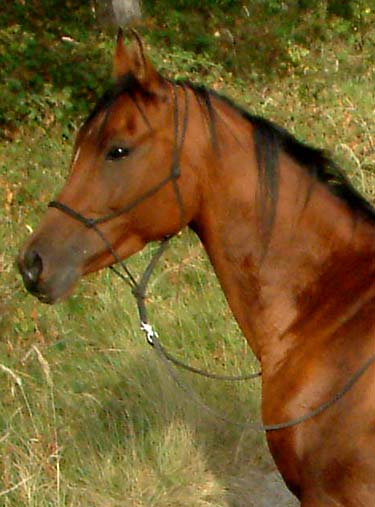
You see them more and more: people riding their horses with a bitless bridle. Can that be done responsibly? Do those people happen to have a super smooth horse, or is there something else going on?
- Why bitless?
- bitless bridles
- Mechanical hackamore
- Switch to bitless
- (#plaats) placement
- Bitless Instruction
- FAQs
- Our own experiences
- (#bronnen)
Preface
We already placed this page on Paard Natural at the beginning of 2005, the page is still up to date, but we are pleased to announce that since the publication of this page, bitless riding has made huge leaps forward. Countless people have now proven in practice that, with the right approach, it is very easy to ride horses bitlessly. In an awful lot of cases it even goes much better than with bit (after reading this book "Metal in the Mouth" written by Professor Dr. WR Cook you will fully understand why!). Humans have had particularly good results with hot, unstoppable, stressful Thoroughbreds as well as pushy, self-perpetuating coldbloods and everything in between. Under the saddle and in front of the cart, recreational and in sports.
Our website visitors already have a lot of fun bitless photo reports placed on the site. Several websites have now even been made especially about bitless driving. Bitless riding is the new normal!
Why bitless?
Maybe we should reverse the question first: What do we need a bit for?
Communication
In order not to sit on the horse's back like a willless passenger, we need a means of communication: we will have to be able to make known to the horse our wishes with regard to the direction and speed to be chosen.
Over the centuries countless methods have been devised for this much-needed communication, varying from body language, voice commands, various bitless solutions, to of course ultimately the bit in all its variants. Is one better than the other? As long as it is not really about communication, just as Dutch would not be more or less suitable for communication than English, or even sign language. As long as both parties master the same language, everything will be fine.
The examples that any language can be suitable for communicating with the horse are numerous. There are many people who can delicately demonstrate that they can not only ride their horse without mechanical aids but can even do high-school tricks, such as the piaffe on a horse without any bridle.
Coercive measures
Communication ok, but what if he doesn't cooperate?
Especially in these modern times we have become used to having everything under control. It is inconceivable that you hit the brakes in the car but that the thing does not give home, and when it happens to you it turns out to be a very scary experience. Things that can escape our control terrify us: "loss of control" is the most terrifying thing that can happen to most people.
Maintaining control is therefore essential. In order to maintain control, we quickly fall into wanting to apply "coercion" due to all kinds of psychological and evolutionary backgrounds. The bit seems to be the appropriate means for this, and commerce eagerly jumps into this, as evidenced by the assortment of bits that you find in the average equestrian store. Most bits feature "control enhancing" adjustments such as levers and the like.
However, horses are not animals that easily give in to coercion; they appear to want to go against coercion, also due to evolutionary backgrounds. It is also no longer a secret that countless horses managed to evade the control of the bit. The question is therefore whether the bit, used as a means of coercion, is sufficient. And if the bit works so badly as a coercive force, should you still use it to solve your driving problems?
It has now become apparent that it is better to solve technical driving problems in other ways than with coercive measures. Our page about desensitization you how you can reduce the flight behavior of your horse, and our pages about (*yielding) -before-pressure and the One Rein Stop some ideas on how to teach your horse to "obey" and even to stop in panic situations. Without bit.
And no, we (authors of this article) do not have easy talking. We have a trotter who comes from the racecourse and can hardly be stopped with a bit, our other horses are flight-like Arabs and/or crossbreeds of both. These horse stops are more reliable on a halter than on a bit, you can read how this works on our page about the One Rein Stop .
Disadvantages of the bit
Well, it is possible without a bit, but why would you drive without a bit?
With some straps you can prevent your horse from opening his mouth to say au ... It is considered positive when a horse "foams". However, a horse will naturally not produce saliva during the movement: we do not think it is a sight when you ride a drooling horse. All in all, there are quite a few problems associated with the bit. We have only mentioned a few, the literature also describes the negative influence of the bit on other parts of the digestive system such as the stomach. Enough reasons for us to say goodbye to something whose usefulness is already outdated. Want to know more about what a bit does to the horse? We can give you this through Professor Dr. Recommend WR Cook written book "Metal in the mouth" wholeheartedly. Bitless driving is, for obvious reasons, enjoying increasing popularity. As the popularity grows, the number of different types of bitless bridles goes up in step. If you have decided that, due to the disadvantages of the bit, you do not want to use a bit (anymore), which bridle should you choose? Broadly speaking, there are two types of bitless bridles: the means of communication and the means of coercion. If we take a look at the bitless optics that are designed as a means of communication, it turns out that they don't differ that much (see also our test: Bitless Optoms ). Not surprising really: when it comes to communication, it is just how you have agreed on the language between you and your horse. For example, you can teach your horse that "pulling on the left rein" means that he should go right. If that's the deal between you and your horse and it works well, why not? In this way you can use any means of communication, because the means of communication has become subordinate to the agreements you make with your horse. Our own experience is that once you leave the path of coercion, you are less dependent on the bridle anyway. Horses appear to respond to more subtle signals, which sometimes makes it seem like your horse can read your thoughts and is already responding before you actually give a "rein aid". Many riders are surprised to discover that the switch from halter to a string around the neck means nothing at all and the horse responds as usual to exactly the same rein aids. This way we can ride our horses with any bitless bridle without actually discovering a difference. You can buy a terribly expensive bitless bridle that is marketed with a lot of commercial tam-tam, and there's nothing wrong with that. However, do not expect magical results, a cheap self-tied halter will often suffice as well. We even recommend that you tie your halter yourself; this way you can design the halter entirely to your own taste and last-but-not-least, make it exactly to size. A stable halter is often less effective due to the weight, the rigid construction and the many metal parts that transmit disturbing signals. In general, we would say: the lighter and simpler the construction, the better it works. We have examined several riding halters from the category "means of communication"; the article is called Bitless Optomingen . Have you ever tried to pull a nail out of wood with your bare hands? It does not work! Grab a lever (the split side on the back of a hammer) and get that nail out, that's a piece of cake! That is the difference between without and with leverage. The forces on the horse's head (the nail) are very high, while it feels very light for the hand on the rein (or on the handle of the hammer). Just a little bit more attention to the hackamore. A mechanical hackamore with lever (you get leverage by scissors but also by the 'circle/flower'!) Is not horse-friendly and we do not think this is an acceptable bitless bridle. This is a bridle that is not based on communication but on coercion. If you are riding with such a harness because otherwise it is not going well, then it is really important to go back to the basics: refining groundwork, mutual understanding and communication. Due to the lever on the bridle, the power of the rider works many times more strongly. The problem is that you don't even notice it yourself. Have you ever tried to pull a nail out of wood with your bare hands? It does not work! Grab a lever (the split side on the back of a hammer) and hupsakee that nail will be out in no time, piece of cake. That is the difference between without and with leverage. The forces on the horse's head (the nail) are very high, while it feels very light for the hand on the rein (or on the handle of the hammer). The lever of the mechanical hackamore converts a pulling force on the rein into a rotating force on the bridle. The horse gets a lot of pressure all the way around his nose and the strap behind the ears is also tightened. And all with leverage, so you don't even feel how much pressure you put. Keep this in mind if you see a horse's head skull later in this article. It is noticeable that the nasal bone is very thin and vulnerable ... So if your horse is dear to you, just make sure you train the horse well enough that lever riding is not necessary. With the right training you can also ride as light as a feather on a bridle without nasty levers. It depends a bit on your former riding style whether you can immediately switch to a bitless bridle or whether some "retraining" is needed first, for both rider and horse. It is important that your horse has learned to give way to pressure, because this is what riding with a bitless bridle is based on. To be sure, read our article about district-before-pressure . An absolute must is to teach your horse the one-rein-stop. This is your emergency brake, not only useful for horses that are ridden with a bit, but essential for those who want to ride bitless. It is this way of stopping with which we know how to safely move the greatest of the renegades to a stop. See our article about the One Rein Stop . Good preparation for bitless riding consists of following some natural horsemanship course. For most people bitless riding is part of the program (in most schools you can only start using a bit when you no longer need the bit to keep your horse under control, so bitless riding is started). We ourselves have good experiences with Parelli Natural Horsemanship, but of course there are also other good methods. A few differences from driving with a bit: It is advisable to try out a new bridle first in a closed environment. Once you have switched to a bitless bridle you will experience that your horse walks more relaxed, shows less resistance, gets wider and more even gaits, and all this has less reason to push his back. Other benefits include: Once bitless, most people also remain bitless. Why go back to a bit, with all its straps, etc. if you can do without it? Make sure you don't put the noseband too low. In the photo you can see Khani and a horse skull where the noseband is in a similar place. He is good on the left. It is too low on the right. If you've ever held a horse skull and felt how fragile that bone is, you know why ... Here you can see it from the front. The very tip of the nose bone is really very thin A neighing horse, do you also imagine that a noseband that is too low can also quickly hinder the horse's air supply? All in all, reason enough to have the noseband on the solid part of the nose bone Are you looking for bitless instruction? The ladies of the Facebook group have put bitless addresses on the map! Check the map to see if there is a bitless instructor near you. Also read the page operation bitless optics tested Is driving without a bit safe? Driving without a bit is no more dangerous than driving with a bit. Many horses just run through the bit, so the bit is not that safe. What is much more important is what you have taught your horse. If you replace the bit with a bitless bridle but you keep riding like the horse has a bit in its mouth, you have skipped a step and you have a chance that it doesn't work. After proper training, for both rider and horse, in which the one-rein-stop is an important part, it appears that bitless is certainly not inferior to the bit in safety. In fact, bitless turns out to be victorious in panic situations, not least because pain stimuli further stimulate the flight instinct of a prey animal, and the effect of the bit is simply based on the application of pain stimuli. Are you insured if you drive without a bit? Despite all the myths that circulate, we can safely answer "yes" to this. Two types of insurance apply: health insurance and WA (Third Party Liability). Health insurance policies pay always, even if you are in hospital because of smoking or even an outright suicide attempt: Own-fault-thick-bump is not an argument for health insurance. Regarding the WA: it pays out if you are held liable for damage caused by you. For example, if you kick a ball through a neighbor's window, it doesn't matter whether you were wearing approved football boots or if you kicked the ball with your sandals. Likewise, it does not matter if you cause lumps with your horse exactly how you managed to do that, with or without a bit, or even without anything. Can the horse curl enough with a bitless bridle? You can teach a horse everything; we have even seen horses in a curl without any bridle. However, the question is whether this is really necessary: The horse is not made to walk in such an unnatural position. Eyesight, breathing, etc. function better when the horse walks in a more natural position. That this would be necessary for the back is a wet monkey story : if this were true then dressage horses should live longer than horses from other disciplines that are less ridden in the curl, but nothing has shown that this is so. But that's actually something for another article ... But what about gaited horses? You need a bit to tölten, right? You can teach a horse everything, why not the gaits? Our Jack, a trotter, will not turn on his own, but he can. And that works fine on a rope halter ...! The designer of the LibraRB halter, for example, rides Icelanders himself and developed the halter with it. So it works fine! But a rope halter is also not friendly because of the buttons that press on nerves? This story has been circulating for a long time but there is no anatomical justification for it. We can also say from our own experience that it makes no difference whether or not you have buttons, or where they are exactly. As you can see in the pictures, the buttons on each halter are in a different place, but you can assume that "nerve points" (if any) are in specific places. And if you do believe in it, don't you just take a bitless bridle without knots? The rope halters that we know ourselves are tied with the smallest possible knot (single line in the knot instead of double). Because regardless of nerve points, it is of course true that a node gives a pressure point. We once started with horses that were very difficult to stop, with bit. Our horses taught us that we were doing something wrong and that the bit was completely pointless and we had to turn in a different direction if we wanted to keep control of the horse. Since about 2004 we have been riding our horses exclusively bitless, on a rope halter, also during long rides and even multi-day hikes, through the city, on the beach, in walk or rengalop. The horses we ride are definitely not softies: Jack and Baladeika were our teaching horses, thanks to their reaction to riding with a bit, we have had to (and want to) develop towards a different way of riding and handling horses. All the horses we got after that time have never worn a bit because by then we were already fully convinced that a bit is neither necessary nor desirable. We are very grateful to our teachers Baladeika and Jack that they are not the easy-going type and that they showed us the way to listen and come up with good solutions. After our teaching horses, more horses came to live with us:
However, when the horse has something in its mouth, even if it is "only" a bit, "eating signals" are sent to the brain. The chewing reflex is activated and the horse starts to make tongue and jaw movements. At the same time, the production of saliva is stimulated. The horse is asked by the rider to move, causing the brain to receive contradictory messages, creating a physiological conflict, and simultaneously activating the sympathetic (movement) and parasympathetic (rest and eating) systems.
Due to the salivation generated by the bit, horses are stimulated to swallow. But while swallowing, the airway is blocked (just like in humans). In a galloping horse, breathing follows the rhythm of the leg movements; swallowing disrupts this choreography.
Horses use their relatively heavy head as a balancing device, in the same way that smaller mammals use their relatively heavy tail for that purpose. The horse's head makes subtle movements to keep the gait clean; when the horse can no longer weigh its head freely, the gait becomes less efficient.
The bit often bumps against molars, and lies in the sensitive area where the wolf teeth that have not yet come through press just below the surface. Horses change their milk teeth for their permanent teeth between 2 and 5 years old and often have to walk with a bit during this period, when they already have a sore mouth.
Bitless bridles
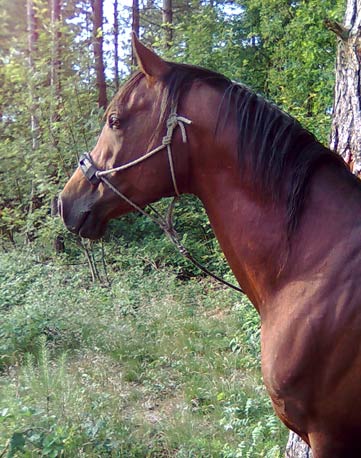
Also in the field of bitless bridles there are unfortunately people who have not yet fully understood what it is about and have come up with all kinds of ingenious pinch, prick and lever constructions. Although these new torture tools avoid some of the disadvantages of the bit, they introduce completely new problems: it has already been found that the nose bone of a horse is extremely fragile ... As a general rule, it is better to leave structures equipped with levers and other torture devices. can leave it.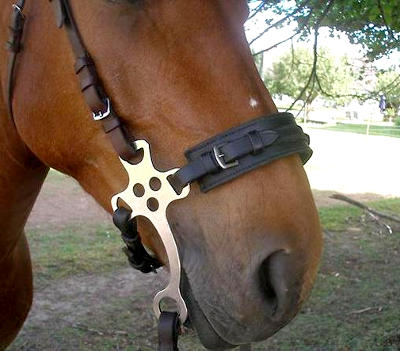
Hackamore
Switch to bitless
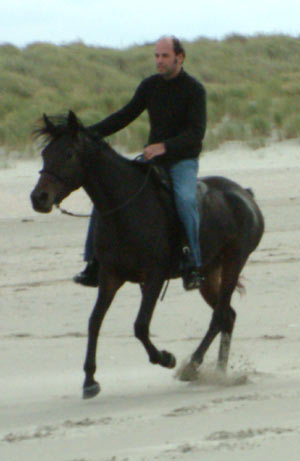
In the photo album we have a special section where readers of the website have posted reports and photos of their horses with which they show off bitless riding (if you have nice photos yourself, put them on it to inspire others! ). See the photo section Natural Horsemanship .
Noseband placement
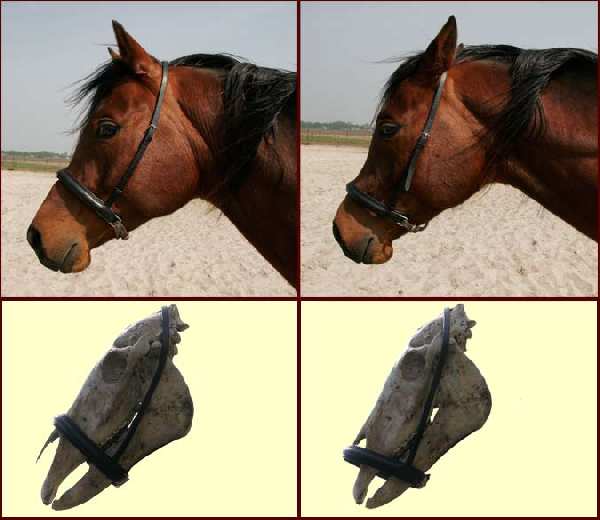
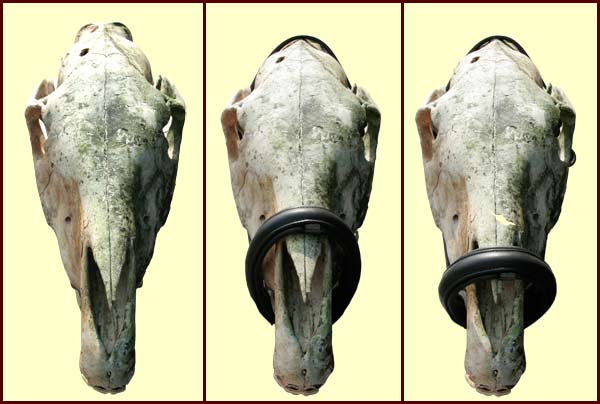
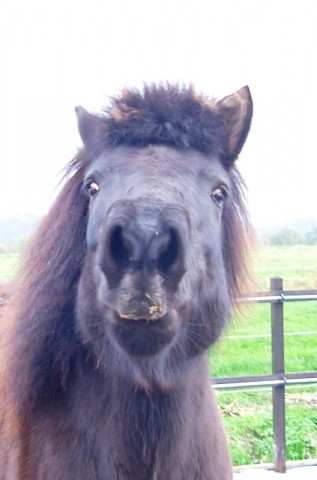
Bitless instruction
Frequently Asked Questions
Our own experiences